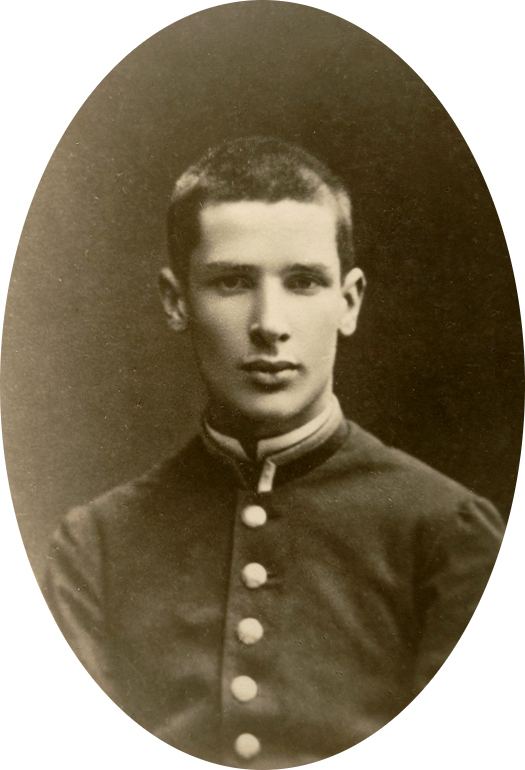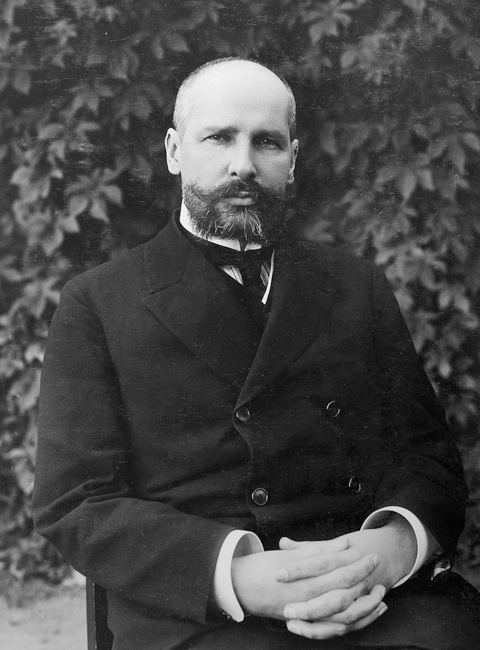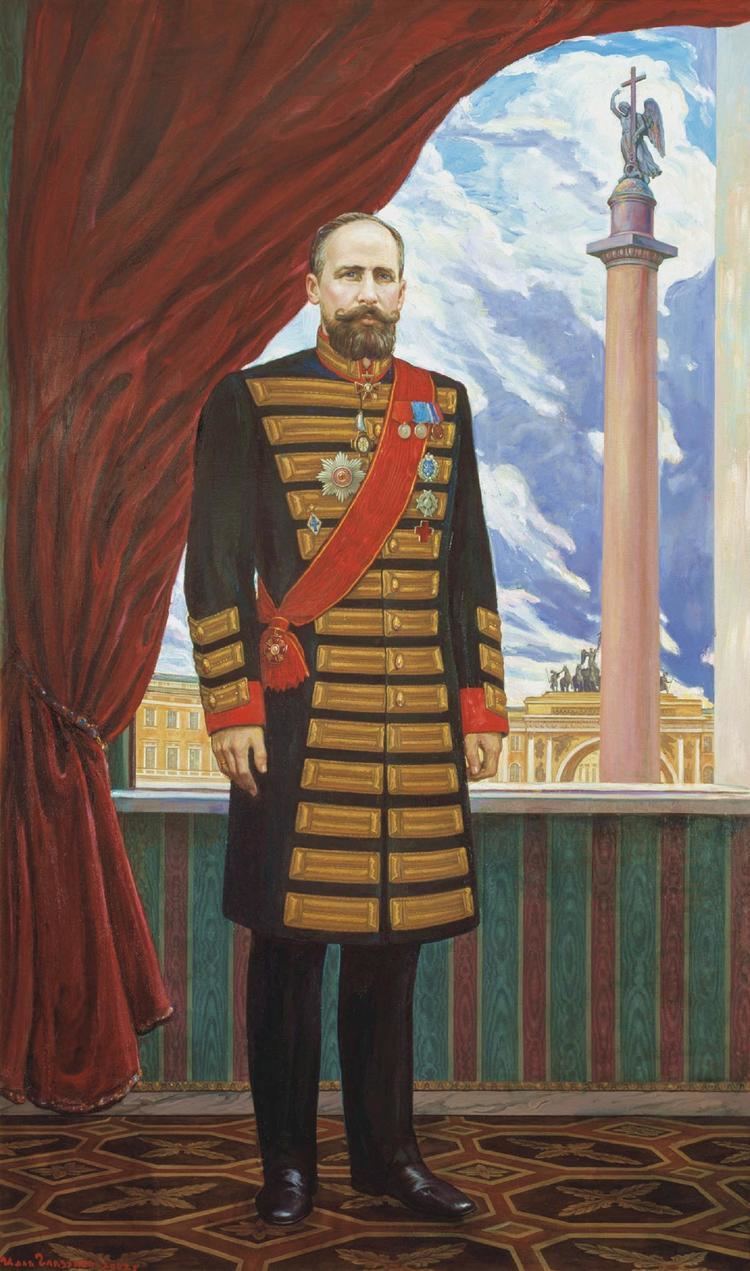Nationality Russian Name Pyotr Stolypin | Children Arkadi Stolypine | |
 | ||
Full Name Pyotr Arkadyevich Stolypin Parents Natalia Mikhailovna Gorchakova, Arkady Dmitrievich Stolypin Siblings Alexander Stolypin, Michael Stolypin, Maria Stolypina Similar People Sergei Witte, Nicholas II of Russia, Vyacheslav von Plehve, Alexander Krivoshein, Mikhail Speransky | ||
Resting place Kiev Cave Monastery | ||
Stolypin and Agriculture
My tribute to Pyotr Stolypin
Pyotr Arkadyevich Stolypin (Russian: Пётр Арка́дьевич Столы́пин; [pʲɵtr ɐˈrkadʲjɪvʲɪtɕ stɐˈlɨpʲɪn]; 14 April [O.S. 2 April] 1862 – 18 September [O.S. 5 September] 1911) was the 3rd Prime Minister of Russia, and Minister of Internal Affairs of the Russian Empire from 1906 to 1911. His tenure was marked by efforts to counter revolutionary groups and by the implementation of noteworthy agrarian reforms. Stolypin was a monarchist and hoped to strengthen the throne. He is considered one of the last major statesmen of Imperial Russia with clearly defined public policies and with the determination to undertake major reforms.
Contents
- Stolypin and Agriculture
- My tribute to Pyotr Stolypin
- Family and background
- Governor and interior minister
- Prime Minister
- Assassination
- Legacy
- References

Family and background

Stolypin was born in Dresden, Germany, on 14 April 1862, and was later baptized on 24 May in the Russian Orthodox Church in that city. His father, Arkady Dmitrievich Stolypin (1821–99), was at the time a Russian envoy in Germany.

Stolypin's family was prominent in the Russian aristocracy, his forebears having served the tsars since the 16th century, and as a reward for their service had accumulated huge estates in several provinces. Father Arkady Dmitrievich Stolypin (1821–99), was a general in the Russian artillery, the governor of Eastern Rumelia and commandant of the Kremlin Palace guard. He was married twice. His second wife, Natalia Mikhailovna Stolypina (née Gorchakova; 1827–89), was the daughter of Prince Mikhail Dmitrievich Gorchakov, the Commanding general of the Russian infantry during the Crimean War and later the governor general of Warsaw.

Pyotr grew up on the family estate Serednikovo, once inhabited by Mikhail Lermontov, and near Moscow. From 1869, Stolypin spent his childhood years in Kalnaberžė manor (now Kėdainiai district of Lithuania), built by his father, a place that remained his favorite residence for the rest of life. In 1876, the Stolypin family moved to Vilnius (now capital of Lithuania), where he attended grammar school. In 1879 the family moved to Oryol. Stolypin and his brother Aleksandr studied at the Oryol Boys College where he was described by his teacher, B. Fedorova, as ‘standing out among his peers for his rationalism and character.’

In 1881 Stolypin studied agriculture at St. Petersburg University where one of his teachers was Dmitri Mendeleev. He entered government service upon graduating in 1885, writing his thesis on tobacco growing in the south of Russia. It is unclear if he joined the Ministry of State Property or Internal Affairs.
Stolypin served as marshal of the Kovno (now Kaunas, Lithuania) Governorate between 1889 and 1902. This public service gave him an inside view of local needs and allowed him to develop administrative skills. He was fascinated by the common lifestyle of the Northwestern Krai and sought to propagate their privately owned, single-family farmsteads throughout the Russian Empire.
Stolypin’s service in Kovno was deemed a success by the Russian government. He was promoted seven times, culminating in his promotion to the rank of state councilor in 1901. Four of his daughters were also born during this period; his daughter Maria recalled “this was the most calm period his life”.
In 1884, Stolypin married Olga Borisovna Neidhart – whose family was of a similar standing to Stolypin’s. They married whilst Stolypin was still a student – an uncommon occurrence at the time. The marriage began in tragic circumstances; Olga had been engaged to Stolypin’s brother, Mikhail, but became engaged to Stolypin following Mikhail’s death in a duel. Their marriage was a happy one, devoid of scandal; the couple had five daughters and one son.
Governor and interior minister
In May 1902 Stolypin was appointed governor in Grodno, where he was the youngest person ever appointed to this position. In February 1903 he became governor of Saratov. Stolypin is known for suppressing strikers and peasant unrest in January 1905. According to Orlando Figes its peasants were among the poorest and most rebellious in the whole of the country. It seems he cooperated with the zemstvos, the local government. He gained a reputation as the only governor able to keep a firm hold on his province during the Revolution of 1905, a period of widespread revolt. The roots of unrest lay partly in the Emancipation Reform of 1861, which had given land to the Obshchina, instead of individually to the newly freed serfs. Stolypin was the first governor to use effective police methods. Some sources suggest that he had a police record on every adult male in his province. His successes as provincial governor led to Stolypin being appointed interior minister under Ivan Goremykin in April 1906. He instigated a new track of the Trans-Siberian Railway along the Amur River within Russian borders.
Prime Minister
After two months Dmitri Feodorovich Trepov suggested the absent-minded Goremykin ought to step down and promoted a cabinet with only Kadets, which in his opinion would soon enter into a violent conflict with the Tsar and fail. He secretly met with Pavel Milyukov. Trepov opposed Stolypin, who promoted a coalition cabinet. Georgy Lvov and Alexander Guchkov tried to convince the tsar to accept liberals in the new government.
When Goremykin, according to S. Witte a bureaucratic nonentity, resigned on 21 July [O.S. 8 July] 1906 Nicholas II appointed Stolypin also as Prime Minister, while he continued as Minister of Interior, an unusual concentration of power in Imperial Russia. He dissolved the Duma, despite the reluctance of some of its more radical members, in order to facilitate government cooperation. In response, 120 Kadet and 80 Trudovik and Social Democrat deputies went to Vyborg (then a part of the autonomous Grand Duchy of Finland and thus beyond the reach of Russian police) and responded with the Vyborg Manifesto (or the "Vyborg Appeal"), written by Pavel Milyukov. Stolypin allowed the signers to return to the capital unmolested.
On 25 August 1906, three assassins from the Union of Socialists Revolutionaries Maximalists, wearing military uniforms, bombed a public reception Stolypin was holding at his dacha on Aptekarsky Island. Stolypin was only slightly injured by flying splinters, but 28 others were killed. Stolypin's 15-year-old daughter was heavily wounded; his 3-year-old son was slightly wounded, standing with his sister on the balcony. Stolypin moved into the Winter Palace. In October 1906, at the request of the Tsar, Grigori Rasputin paid a visit to the wounded child.
Stolypin changed the nature of the Imperial Duma to attempt to make it more willing to pass legislation proposed by the government. After dissolving the Second Duma on 8 June 1907 (Coup of June 1907), 15 Kadets, who had been in contact with terrorists, were arrested; he changed the weight of votes more in favor of the nobility and wealthy, reducing the value of lower class votes. The leading Kadets were ineligible. This affected the elections to the Third Duma, which returned much more conservative members, more willing to cooperate with the government. It changed Georgy Lvov from a moderate liberal into a radical.
In Saratov, Stolypin had come to the conviction that the open field system had to be abolished. Like in Denmark, he introduced land reforms in order to resolve peasant grievances and quell dissent. Stolypin's reforms aimed to stem peasant unrest by creating a class of market-oriented smallholding landowners. He was assisted by Alexander Krivoshein, 1908 becoming the Minister of Agriculture. He aimed to create a moderately wealthy class of peasants that would support societal order. (See article "Stolypin's Reform"). He tried to improve the lives of urban laborers and worked towards increasing the power of local governments, but the zemstvos adopted an attitude hostile to the government.
Leo Tolstoy was particularly indignant. He wrote to Stolypin directly and said, "Stop your horrible activity! Enough of looking up to Europe, it is high time Russia knew its own mind!" That was the argument that Tolstoy often had with Dostoyevsky, who was in favor of private ownership of land. Dostoyevsky wrote: "If you want to transform humanity for the better, to turn almost beasts into humans, give them land and you will reach your goal."
Since 1905 Russia was plagued by revolutionary unrest and discontent was widespread among the population. With broad support, leftist organizations waged a violent campaign against the autocracy; throughout Russia, many police officials and bureaucrats were assassinated. "Stolypin inspected rebellious areas unarmed and without bodyguards. During one of these trips, somebody dropped a bomb under his feet. There were casualties, but Stolypin survived." To respond to these attacks, Stolypin introduced a new court system of martial law, that allowed for the arrest and speedy trial of accused offenders. Over 3,000 (possibly 5,500) suspects were convicted and executed by these special courts between 1906 and 1909. In a Duma session on 17 November 1907, Kadet party member Fedor Rodichev referred to the gallows as "Stolypin's efficient black Monday necktie". As a result, Stolypin challenged Rodichev to a duel, but the Kadet party member decided to apologize for the phrase in order to avoid the duel. Nevertheless, the expression remained, as did "Stolypin car".
Stolypin attempted to improve the acrimonious relations between Russian Orthodox and Jewish citizens at the level of nationalities policy. Sergey Sazonov was the brother-in-law of Stolypin and did his best to further his career; in 1910 he became Minister of Foreign Affairs, following Count Alexander Izvolsky. Around 1910 the press started a campaign against Rasputin, who was said to have paid too much attention to young girls and women. Stolypin wanted to ban him from the capital and threatened to prosecute him as a sectarian. Rasputin went on a trip to Jerusalem and came back to St. Petersburg only after Stolypin's death.
"Stolypin resigned in March of 1911 from the fractious and chaotic Duma after the failure of his land-reform bill". He had proposed spreading the system of zemstvo to the southwestern provinces of Russia. It was originally slated to pass with a narrow majority, but Stolypin's political opponents stopped it. Tsar Nicholas II decided to look for a successor to Stolypin and considered Sergei Witte, Vladimir Kokovtsov and Alexei Khvostov.
Pyotr Stolypin's reforms produced astounding results within a few years. Between 1906 and 1915, thanks to the efforts of Stolypin's farmers, the productivity of crops nationwide grew by 14 percent, in Siberia by 25 percent. In 1912, Russia's grain exports exceeded by 30 percent those of Argentina, the United States and Canada combined.
Assassination
Stolypin traveled to Kiev, despite police warnings that an assassination plot was afoot. (There had already been 10 attempts to kill him.)
On 14 September [O.S. 1 September] 1911, there was a performance of Rimsky-Korsakov's The Tale of Tsar Saltan at the Kiev Opera House in the presence of the Tsar and his two oldest daughters, the Grand Duchesses Olga and Tatiana. The theater was occupied by 90 men posted as interior guards. According to Alexander Spiridovich, after the second act "Stolypin was standing in front of the ramp separating the parterre from the orchestra, his back to the stage. On his right were Baron Freedericks and Gen. Sukhomlinov." His personal body guard had stepped out to smoke. Stolypin was shot twice, once in the arm and once in the chest by Dmitry Bogrov, a leftist revolutionary. Bogrov ran to one of the entrances and was caught. "He [Stolypin] turned toward the Imperial Box, then seeing the Tsar who had entered the box, he made a gesture with both hands to tell the Tsar to go back." The orchestra began to play "God Save the Tsar." The doctors hoped Stolypin would recover, but, despite never losing consciousness, his condition deteriorated. He died three days later.
Bogrov was hanged 10 days after the assassination. The judicial investigation was halted by order of the Tsar, giving rise to suggestions that the assassination was planned not by leftists, but by conservative monarchists who were afraid of Stolypin's reforms and his influence on the Tsar. This, however, has never been proven. On his request, Stolypin was buried in the city where he was murdered.
Legacy
The opinions on Stolypin's work are divided. Some hold that, in the unruly atmosphere after the Russian Revolution of 1905, he had to suppress violent revolt and anarchy. However, historians disagree over how realistic Stolypin's policies were. The standard view of most scholars in this field has been that he had little real chance of reforming agriculture since the Russian peasantry was so backward and he had so little time to change things. Others, however, have argued that, while it is true that the conservatism of most peasants prevented them from embracing progressive change, Stolypin was correct in thinking that he could "wager on the strong" since there was indeed a layer of strong peasant farmers. This argument is based on evidence drawn from tax returns data, which shows that a significant minority of peasants were paying increasingly higher taxes from the 1890s, a sign that their farming was producing higher profits.
There remains doubt whether, even without the interruption of Stolypin's murder and the First World War, his agricultural policy would have succeeded. The deep conservatism from the mass of peasants made them slow to respond. In 1914 the strip system was still widespread, with only around 10% of the land having been consolidated into farms. Most peasants were unwilling to leave the security of the commune for the uncertainty of individual farming. Furthermore, by 1913, the government's own Ministry of Agriculture had itself begun to lose confidence in the policy. Nevertheless, Krivoshein became the most powerful figure in the Imperial government.
In "Name of Russia", a 2008 television poll to select "the greatest Russian", Stolypin placed second, behind Alexander Nevsky and followed by Joseph Stalin. He is seen by his admirers as the greatest statesman Russia ever had, the one who could have saved the country from revolution and the civil war.
On 27 December 2012 a monument to Pyotr Stolypin was unveiled in Moscow, near the Russian White House where the Russian Cabinet is situated.
